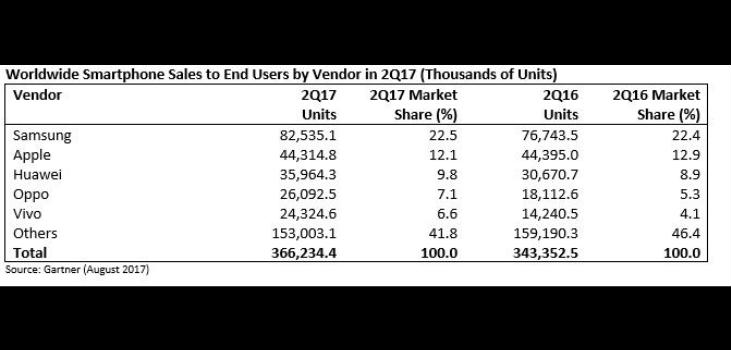While the global sales of smartphones to end users totaled 366.2 million units in the second quarter of 2017 -- a 6.7 per cent increase over the same period last year, Android extended its lead with 87.7 per cent market share in the operating system market surpassing iOS that accounted for just 12.1 per cent share.
Samsung's smartphone sales grew 7.5 per cent, year-over-year, after three consecutive quarterly decline. The company was hit hard by the Galaxy Note 7 fiasco, but made the comeback with the Galaxy S8 and S8+, market research firm Gartner said.
Despite clearing the distribution channel of iPhone inventory amounting to 3.3 million units during the second quarter, Apple's sales were flat (down 0.2 per cent), year-over-year.
“Apple's sales in emerging markets are expected to grow as older-generation iPhones continue to attract buyers. The new iOS 11, which will include augmented reality, machine learning, an improved Siri and a new display design, will likely fuel strong iPhone sales in the fourth quarter of 2017, and help Apple increase its sales in 2017," said Anshul Gupta, Research Director at Gartner.
Vivo and Oppo achieved the best performances in the second quarter of 2017, with year-over-year sales increases of 70.8 per cent and 44.1 per cent, respectively.
"Although demand for utility smartphones remains strong, there is growing demand in emerging markets for 4G smartphones, with more storage, better processors and more advanced cameras. This is translating into higher demand for midpriced [$150 to $200] smartphones," said Gupta.

Sales of all types of smartphone grew in the second quarter of 2017, compared with the second quarter of 2016. However, there is a concern about rising component costs, as well as limited supply, due to the reduced availability of critical components.
Shortage of flash memory and OLED [organic light-emitting diode] displays are expected to affect the premium smartphone supply in the second half of 2017. For example, Huawei's P10 suffered from a flash memory shortage, and smaller, traditional brands, such as HTC, LG and Sony, are stuck between aggressive Chinese brands and the dominating market shares of Samsung and Apple in the premium smartphone segment.
Greater China and emerging Asia/Pacific markets drove sales of smartphones in the second quarter of 2017, with market shares of (27.7 percent) and (21.4 percent), respectively. Growing smartphone penetration of India, Indonesia and Southeast Asian countries drove a year-over-year rise in smartphone sales in the emerging Asia/Pacific group.
However, smartphone sales in Greater China declined, year-over-year, primarily due to longer replacement cycles and as users prefer to buy better smartphones.
